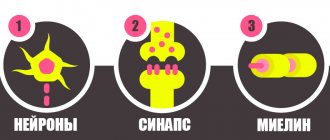Children with weakened right hemisphere function usually do well academically, but may have difficulties socially and behaviorally. Our brain consists of two hemispheres. Children with behavioral, academic, social or other problems often have an imbalance where they preferentially use one part of the brain. This causes one side of the brain to become stronger while the other develops more slowly.
Although research has shown that we use our entire brain to process information, children tend to exhibit characteristics associated with the "dominance" of different hemispheres of the brain. It was once believed that the brain was static, unable to grow or change. But extensive research and in-depth study of epigenetics have shown that the brain is remarkably adaptable, capable of creating new neural connections in response to stimuli in the environment. This is a branch of science called neuroplasticity.
Understanding the different brain responses can have a big impact on how your children learn. Problems most commonly reported by children and adolescents due to the apparent dominance of one hemisphere when processing information include:
- Tendency to get distracted and problems concentrating
- Uneven attention to detail
- Problems with time management
- Problems with organization
- Impulsiveness
- Mood swings and behavioral fluctuations
- Sensory processing problems
Brain Balance does not require the child to have a medical diagnosis, and we are not talking about clinical diagnosis of diseases. In this article, we focus on understanding the challenges these children face and helping them develop and strengthen neural connections. Research has found that the unique challenges your child faces may be related to weak connections in different areas of the brain. Fortunately, homeschoolers (virtually every homeschooler these days) have endless opportunities for creativity, individualization, and effectiveness in meeting the needs of right-brain dominant children.
What if your child is right-brain dominant?
Scientists have proven that children with a strong left hemisphere love structure, focus on details, love organization and logic. They can easily express their feelings and thoughts in words. Memorization comes easily to them, and left-brain dominant students tend to learn best through repetition. These children work efficiently using a step-by-step approach, enjoy working independently, have a good sense of time, and are objective.
Writing and spelling tend to come easily to these students, and they tend to learn well “by instruction.” Arithmetic, with its logical sequential steps, is also a subject in which left-brain dominant children often excel, although conceptual math subjects such as geometry or chemistry may be more difficult for them. Children with a strong left brain tend to benefit from auditory learning and often demonstrate academic ability early.
On the other hand, right-brain oriented students have visual abilities. They focus on holistic concepts rather than details and tend to be unstructured and impulsive and creative. They often demonstrate mastery of art or music. These children do not like to work independently; They learn best through discussion, interaction, collaboration and active participation in what they are learning.
Right-brain dominant children think in pictures rather than words, typically have a good sense of spatial orientation (but a poor sense of time), and are attuned to emotions. These children prefer the main idea to the details and often learn in spurts rather than in a consistent sequence. Right-brain oriented learners often reach conclusions intuitively without knowing what steps they took to arrive at the answer, and often prefer a visual or kinesthetic learning style. Children with a right-brain orientation are often “late bloomers” academically.
What if your child is left-brain dominant?
In another study, researchers focused on the "superpowers" of children whose left hemisphere apparently dominates behavioral patterns. The left hemisphere of the brain controls learning and information processing. Children with a weak right hemisphere tend to be more analytical in their thinking and usually do well academically. They are better at remembering large amounts of data, have a large vocabulary and are detail oriented.
If your child is left-brain dominant, you will notice that he or she exhibits certain characteristics at home. For example, he or she may stick to the same routine, such as eating the same foods for breakfast, lunch, and dinner. Children who are left-brain dominant are also good at following directions.
One of the most noticeable characteristics of left-brain dominance is a tidy room. If you rarely tell your child to clean up, he or she may be left-brain dominant. As helpful as this can be at home, you may notice that many children with a strong left brain are not very emotional or affectionate. Instead, they tend to be logical thinkers and often enjoy spending time alone, according to Funderstanding.
Training to synchronize the brain hemispheres
Gymnastics, which promotes synchronization (combination of functions) of the brain hemispheres, improves coordination of movements, increases concentration, intelligence, and learning ability. Its benefits also include eliminating anxiety and aggression.
Cross movements
The elbow of the left hand touches the knee of the right leg, the elbow of the right hand touches the knee of the left leg (take into account the fact that it may not work at first). Repeat 20 times. It is good to do this exercise daily. Even a child can handle cross movements, but it is advisable to combine them with unidirectional movements (right hand - right leg, left hand - left leg, repeat - 10 times). You should always end the lesson with a cross movement.
United fingers
Place the fingers of both hands with the upper knuckles facing each other and imagine the letter X for a minute (left thumb with right thumb, right index finger with left index finger, etc.). The left hand represents the right hemisphere, the right - the left. Using Method X forces the hemispheres to cooperate.
Palm clapping
The activity is suitable for children and adults. In pairs or each individual (for example, opposite a wall), you should clap your palms crosswise and parallel. The exercise always ends with cross clapping.
Recumbent figure eight
Using a pencil or felt-tip pen, draw the largest possible figure of eight on A3 or A4 paper. The bigger the eight you draw, the better; while working, use the following path:
- Circle your right hand 3 times, start from the center, continue left or right up;
- Repeat the same 3 times with your left hand;
- Use both hands to trace the figure eight in one direction 3 times (both hands holding one pencil or one pencil in each hand);
- Circle the figure eight with both hands 3 times in opposite directions; start from the middle: left hand up to the left, right hand up to the right, then arms cross, ending in a figure eight.
During training, do not tilt your head, make rotations with your eyes, repeating the movements of your hands. The exercise helps improve hand-eye coordination and synchronize both hemispheres of the brain.
Playful drawing (double drawing)
Hold a pencil or felt-tip pen in each hand (a felt-tip pen glides better on the paper), and with both hands at the same time draw figures, faces, symbols - any drawings (house, sun, tree).
Elephant (eights with ears)
Spread your legs slightly, bend them, extend one arm to the side, tilt your head towards it (your ear touches the shoulder of this arm). Follow with your eyes the outstretched fingers of your outstretched hand. Write the largest lying figure eights in the air. Start from the center, continue right or left up. Switch hands and repeat 10 times on each side. Alternative: instead of eight, write letters (words).
Cobra
Lie on your stomach, bent arms, palms on the floor under your shoulders, legs extended. As you exhale, raise your head and rest your hands on your outstretched arms (cobra position). Breathe freely. After 5-10 seconds, slowly return to the starting position. Place your forehead on the floor and rest for a while. Repeat 4 times.
Owl
Place your right (left) hand on your left (right) shoulder above the shoulder blade, inhale. As you exhale, turn your head to the left (right), look back over your shoulder, turn your head back. On your next exhalation, turn your head to the other side of your shoulder and inhale to return to the starting position. Then tilt your head towards your chest, putting stress on the neck muscles. Repeat 4 times.
"Thinking cap"
This exercise for synchronizing the hemispheres of the brain can be performed in 2 ways.
- Place your thumb in the middle of your ear, take the lobe from behind with two fingers, massage (as if you want to twist your ear). Repeat 3 times from bottom to top. Massage both ears at the same time.
- Massage from the top to the earlobe (3 times).
Juggling 3 balls
When juggling, look past the balls, do not concentrate on them, otherwise you will not catch them. With this exercise, two hemispheres of the brain work, the grasping reflex is overcome, thereby freeing the mind. Training removes body blockages.
Parallelism
Take a piece of paper and a pencil in each hand. With both hands at the same time, draw mirror figures - numbers, letters, shapes... If at first it’s difficult, help yourself with instructions out loud - I draw down, I draw to the right...
Drum with both hands, creating a different rhythm with each hand.
Stroking the belly, tapping the crown
With your right hand, stroke your stomach clockwise, and with your left hand tap the top of your head (light tapping enhances thinking and activates brain synchronization). Switch hands, repeat.
Description of circles
With your right leg raised, move in clockwise circles. Use your left hand to make circles counterclockwise. Do both movements at the same time.
Children with a weak right hemisphere at school
Parents aren't the only people who may notice left-brain dominance patterns in children. Teachers also often notice characteristics based on how left-brained children behave in school. The good news is that according to Psychology Today, schools typically cater to children with weak right brains because most classes require strong analytical skills. Children with weak right-brain characteristics tend to excel in:
- Science
- Mathematics
- Reading
- Memorization
- Setting goals
Many of these children prefer to study alone, so make sure your child has a quiet place to do homework. Also, since many children with right-brain weakness tend to do well with lists, give your child the opportunity to make as many lists as possible by providing a board, paper, and writing utensils. Not only will your child be grateful for the help, but they will also likely be successful at school and at home.
Facts about ambidextrous people
- Ambidextrous people make decisions faster.
- Such people can multitask easily.
- The IQ level of ambidextrous people is higher than that of left-handers and right-handers.
- Among the famous and most prominent ambidexters are Leonardo da Vince, Jimi Hendrix and Maria Sharapova.
- Ambidexterity can be congenital (1% of children) or acquired, developed independently.
- Ambidextrous people are hyperactive.
- Ambidextrous people can write the same word or draw the same shape with both hands at the same time.
How can you use this information to help your child?
If a child has a weak right hemisphere, he may be socially immature and have little interest in sports or outdoor activities. Instead of forcing your child to take karate and ballet classes, help him develop his super powers. Send your child to a STEM school, take programming courses, buy him supporting literature on physics, biology, or even a foreign language.
Scientists involved in brain neuroplasticity recommend that parents do not strive for “absolute brain balance.” (For example, trying to compensate for a love of science with sports endeavors.) Development of your child’s abilities, if it does not have clinical prerequisites (Attention Deficit Hyperactivity Disorder (ADHD), Oppositional Defiant Disorder (ODD), Processing Disorders (APD), Visual, Sensory Disorders (SPD), Learning Disorders (Dyslexia, Dysgraphia, Dyscalculia, Dyspraxia) do not require outside intervention.
Working with the left hemisphere can help a child with a predisposition to art, as well as a child who loves physics. Moreover, the development of the left hemisphere eliminates problems of concentration and distracted attention, regardless of which hemisphere is dominant. Our team is ready to help you. Take a second to fill out our form.










